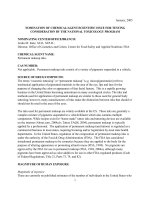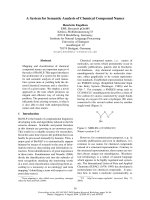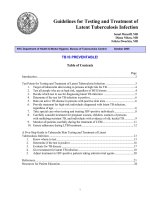NOMINATION OF CHEMICAL/ AGENT/SCIENTIFIC ISSUE FOR TESTING....
Bạn đang xem bản rút gọn của tài liệu. Xem và tải ngay bản đầy đủ của tài liệu tại đây (343.3 KB, 10 trang )
1
January, 2005
NOMINATION OF CHEMICAL/AGENT/SCIENTIFIC ISSUE FOR TESTING
CONSIDERATION BY THE NATIONAL TOXICOLOGY PROGRAM
NOMINATING CENTER/OFFICE/BRANCH:
Linda M. Katz, M.D., M.P.H.;
Director, Office of Cosmetics and Colors; Center for Food Safety and Applied Nutrition; FDA
CHEMICAL/AGENT NAME:
Permanent makeup inks.
CAS NUMBER:
Not applicable. Permanent makeup inks consist of a variety of pigments suspended in a vehicle.
SOURCE OF DRUG/COMPOUND:
The terms “cosmetic tattooing” or “permanent makeup” (e.g. micropigmentation) refer to
mechanical application of pigmented materials to the area of the eye, lips and face for the
purpose of changing the color or appearance of that facial feature. This is a rapidly growing
business in the United States becoming mainstream in many sociological circles. The inks and
methods used for application of permanent makeup are similar to those used for general body
tattooing; however, many manufacturers of inks make the distinction between inks that should or
should not be used in the area of the eyes.
The inks used for permanent makeup are widely available in the US. These inks are generally a
complex mixture of pigments suspended in a vehicle/diluent which also contains multiple
components. While recipes exist for “home-made” tattoo inks and tattooing devices are available
on the internet (About.com, 2004a,b; Tattoo FAQS, 2004), permanent makeup is typically
applied by a professional. The application of permanent makeup (and tattoos) is regulated as a
commercial business in most states, requiring licensing and/or registration by most state health
departments. In the United States, regulation of the composition of permanent makeup inks is
under the authority of the Food & Drug Administration (FDA). The FDA has considered
intradermal permanent makeup to be cosmetics because they are applied to the body for the
purpose of altering appearance or promoting attractiveness (FDA, 1994). No pigments are
approved by the FDA for use in permanent makeup (FDA, 1994, 2004a), although many
pigments have been approved as color additives for use in other FDA-regulated products (Code
of Federal Regulations, Title 21, Parts 73, 74, and 82).
MAGNITUDE OF HUMAN EXPOSURE:
Magnitude of exposure
There are currently no published estimates of the number of individuals in the United States who
2
have received permanent makeup; however, the popularity of this practice and the wide
availability of businesses that offer permanent makeup application, suggest the number of
individuals with permanent makeup will increase over the next several years.
There have been recent estimates of the number of individuals who have tattoos. A recent survey
in Germany indicated that 10% of the population has tattoos (German Federal Institute for Risk
Assessment, 2004). A Harris Poll conducted in the United States in July 2003 determined that
16% of US adults have at least one tattoo (Harris Interactive, 2003). Since the US population is
approximately 280 million, this poll indicates that as many as 45 million US citizens have at least
one tattoo. The poll also indicated that 13% of 18-24 year olds, 36% of 25-29 year olds, and
28% of 30-39 year olds have at least one tattoo.
Pigments in inks used in permanent makeup manufacture
While there have been several publications regarding the chemicals used for coloration in tattoo
inks (Lehmann and Pierchalla,1988; Bäumler et al., 2000; Timko et al., 2001; Danish EPA, 2002;
Cui et al., 2004) little has been published regarding the composition of permanent makeup inks.
Fate of pigments used in tattooing and permanent makeup application
Permanent makeup application involves using a needle or needle assembly to mechanically force
pigments through the epidermis into the dermis. The pigment deposited in the epidermis is
eventually lost due to differentiation and clearance of epidermal keratinocytes. The pigment
deposited in the dermis is either removed by phagocytic cells (neutrophils or macrophages;
Gopee et al., 2004a,b) or remains in the dermis providing the makeup color. The fate of
pigments removed by neutrophils and macrophages remains largely unknown. There have been
reports of tattoo pigments in the lymph nodes of humans (e.g., Dheansa and Powell, 1997;
Moehrle et al., 2001; Zirkin et al., 2001), and the tattooing of mice has resulted in the
accumulation and persistence of tattoo inks in lymph nodes (Gopee et al., 2004a,b). The effect
of long-term exposure of the dermis and lymph nodes to the remaining pigment is not known.
EVIDENCE FOR CENTER/OFFICE CONCERN:
Regulation of permanent makeup inks
There is a paucity of toxicological data on the safety of inks used in this country for permanent
makeup. The FDA has not listed (i.e. permitted) for use any color additives for injection. A
recent event and several publications regarding tattoo inks (see below) have warranted increased
concern regarding the lack of toxicological data.
Infection hazard associated with tattooing
The primary hazard regarding the application of permanent makeup is infection. Historically,
bacterial and viral infections were the most common complaint associated with the related
practice of tattooing (reviewed in Long and Rickman, 1994). Tattooing is a risk factor for
transmission of viral infections (e.g., hepatitis C, HIV) in prison (Loimer and Werner, 1992;
3
Holsen et al., 1993; Long and Rickman, 1994; Thompson et al., 1996; Hellard et al., 2004). The
prevalence of bacterial and viral infections in the general population receiving tattoos is unknown;
however, the regulation of permanent makeup application and tattooing by state health
departments and the enforcement of good hygiene practices is thought to have reduced this
danger.
Adverse reactions to components in permanent makeup inks
Adverse reactions to components of permanent makeup and tattoo inks have been reported;
however, no epidemiological studies have been conducted to substantiate cause and effect, or to
document the magnitude of the problem. Many of the early reports regarding adverse skin
reactions to tattoo inks have been attributed to the use of cinnabar (mercury sulfide; Silverberg
and Morris, 1970), chromium salts (Verdich, 1981), cobalt salts (Rorsman et al., 1969),
manganese salts (Schwartz et al., 1987), cadmium salts (cadmium sulfide, cadmium selenide;
Björnberg,1963), and aluminum-containing pigments (McFadden et al., 1989). Since many of the
current tattoo inks still contain aluminum and cobalt (Timko et al., 2001), it is possible that
adverse reactions could still be due to these minerals.
Hazard of tattoos causing misdiagnoses
The misidentification of black tattoo pigment in lymph nodes for metastatic melanoma has been
reported by Dheansa and Powell (1997) and Moehrle et al. (2001). It is unknown if the
application of permanent makeup would result in a similar diagnostic complications.
Magnetic hazard of iron pigments
There are some reports of intense burning during magnetic resonance imaging of tattooed
individuals (Jackson and Acker, 1987; Carr, 1995; Wagle and Smith, 2000). In the latter report
(Wagle and Smith, 2000) the authors attribute the burn to the loop design of a specific tattoo as
opposed to a generalized phenomenon associated with tattoos containing iron oxide.
Complications associated with permanent makeup (micropigmentation)
There have been reports of adverse skin reactions following micropigmentation or application of
permanent makeup. Duke et al. (1998) reported a case where the second application of red
permanent makeup (naphthanil red) on the lips of a patient resulted in edematous, erythematous,
and crusted lips. Topical steroid treatment for over a year did not completely clear the condition.
Recently, the FDA has been informed of numerous adverse event reports (>50) regarding a
permanent makeup product line (Premier True Color Concentrates) manufactured by the Premier
Products, in Arlington, TX. These adverse event reports prompted an “FDA talk paper” (FDA,
2004b) to be released in July 2004. The FDA is continuing its investigation into the magnitude of
the problems associated with use of these products (a list of the Premier Products’ ink shades
that were recalled as a result of the adverse event complaints are listed in Table 1, and available at
or />FDA, 2004c).
4
One of the recipients of the Premier Products’ permanent makeup has published her story on
several Internet sites (Erfan, N.; see images below). The patient complaints are best summarized
by quoting from one of the articles “The swelling didn’t really go down and my lips became more
irritated until it was obvious that something was wrong. My allergic reaction symptoms consisted
of burning, itching, swelling, bumps or so-called ‘granulomas’, dryness, peeling, bleeding, and
the constant formation of yellowish fluids around my eyes and lips that were impossible to
completely remove. My lips were sensitive to the touch and my eyes hurt when I blinked. I still
can’t open my mouth wide enough to floss my teeth and I have to use baby utensils in order to eat.
In addition, I still have swollen lymph nodes because I have big lumps under my chin and the
sides of my face. At one point, my eyes and lips were infected and I was on antibiotics.”
The images in the above picture are available on-line, published in the article “Permanent make-up tattoos: taboos or
time saver?” by Nancy Erfan at , and were copied from that site for the
purpose of this presentation. The images depict from left to right: 1, patient’s lips prior to permanent makeup
application; 2, swollen lips following permanent makeup application; 3, lips approximately 1 month after picture 2,
and prior to laser treatment; 4, eye prior to permanent makeup; 5, eye after reaction to permanent makeup (picture
taken at same time as picture 2).
Whether the response of Nancy Erfan is characteristic of the numerous complaints of recipients
of Premier Products True Color Concentrates remains to be established; however, the complaints
communicated by Nancy Erfan fit the pattern of either an allergenic or photoallergenic response
to the pigments used to formulate the inks. Despite extensive efforts, CFSAN has been unable to
find toxicological data on the pigments used in these inks. The regulatory responses available to
CFSAN have been limited due to this lack of toxicological data.
The Center for Disease Control and Prevention is collaborating with the FDA and is investigating
the complaints associated with the use of Premier Products True Color Concentrate permanent
makeup inks.
RECOMMENDED STUDIES:
The FDA requires toxicological data to determine the safety of permanent makeup inks. The
FDA recommends that studies be conducted to examine the toxicity, phototoxicity, allergenicity
and photoallergeniciy of permanent makeup inks, including the pigments and/or the solvents or
diluents. The experimental approaches used in these studies should allow identification of the
allergenic and photoallergenic components of inks (i.e. identification of pigments and components
5
of the vehicle/diluent contributing to toxicity/phototoxicity).
The following toxicological studies are recommended, and will focus on components of the shades
of Premier Products that are identified by the Center for Disease Control and Prevention study as
causative shades in the cases of adverse reactions to Premier Pigment True Color Concentrate
inks. The studies will be limited to the components of the implicated shades in an attempt to
identify the etiological agent(s).
(1) In animal studies determine the allergenicity and photoallergenicity of the ink components
identified by the Center for Disease Control and Prevention as probable causative agents. The
investigation by the Center for Disease Control and Prevention should also suggest the type of
immunological reaction that occurred. The specific studies to be conducted will depend on the
outcome of the Center for Disease Control and Prevention investigation. For instance, there are
four main classifications to allergic reactions to drugs (Gell and Coombs, 1963): Type I,
immediate hypersensitivity or anaphylaxis; Type II, antibody-mediated cytotoxic reactions;
Type III, immune complex-mediated reactions; Type IV, delayed hypersensitivity. The model
used to investigate the possible allergenicity (or photoallergenicity) will need to be delineated
since the candidate allergen is deposited into the skin with a tattoo needle. While a classical
approach to allergic contact dermatitis such as the local lymph node assay (Dearman et al., 1999;
Gerberick et al., 2000; Kimber, 2001) would be useful in determining if the candidate agent elicits
contact dermatitis, the assay might not be useful if the candidate agent was introduced by
tattooing, which will induce inflammation at the tattoo site and at the local lymph node (Gopee et
al., 2004b).
Since tattoo pigment has been reported to be present in lymph nodes, the deposition of pigments
in the regional lymph nodes in the animal studies, and any toxicity to the lymph nodes should be
addressed.
(2) Determine the in vitro toxicity and phototoxicity of the pigments identified in the Premier
Products True Color Concentrate products in cells in vitro (e.g. mouse 3T3 fibroblasts or
keratinocytes) with or without illumination by ultraviolet A (UVA)/visible light. While this
approach does not address the immunologic components of the inks, it will determine if any of
the ink pigments are potential photosensitizers. This information will augment the data derived in
approach, and if correlative with the in vivo data, could serve as a short-term in vitro screen for
future products.
REFERENCES:
About.com. 2004a. Tattoo ink chemistry: Pigment chemistry. Available at
(Accessed 21 October 2004).
About.com. 2004b. Tattoo ink chemistry: Carrier chemistry. Available at









